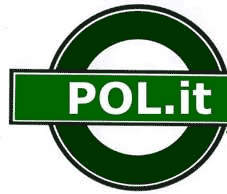 |
|
|
|
|
| Web Technologies in CME Projects, New Ways of Teaching Psychiatry Francesco Bollorino Neuroscience Department — Genoa University First of all, I'd like to rejoice at being here again three years from our previous meeting in Hamburg and at being able to meet friends and colleague again with same interests and the same desire to carry out projects and initiatives that put together psychiatric knowledge and computerized technology. Paraphrasing Paul Simon ("The boxer", Concert at Central Park in 1984, a myth for my generation), I think that we can say that "…after changes upon changes we are more or less the same", speaking about Internet and its applications and implications on Psychiatry and the role WPA and other National Psychiatric Associations will have to play in this chessboard.  I'm very happy to be in Yokohama, "at the other side of the world" for the ones who, as me, arrive form Italy, because the presence of the net in Japan has some specificities that make it unique in the international view: here, Internet, in the these last years, has developed very much essentially as a "wireless" application, differently from the rest of the world where prevails the access to net's services through the more traditional "dial up" system by terrestrial connections. A comparison with applications with Japanese colleagues will be useful to ones, as we Italians, only at the present we are occurring to the "wireless" world with UMTS technology, strict relative of the most diffused DOCOMO i-mode platform here.
This theme is particularly binding in the ambit, because I'll introduce you in my report: the use of net technologies in the field of Continuing Medical Education (CME). I'll start from some general considerations, then I'll pass to the presentation of a distance education model that I've created and that can represent a "case study" and a practical example of my ideas about online CME. The first consideration is about the question (that is valid for every form of online and offline Professional Education): what is the purpose of CME? The distinction, that Jerome Bruner of New York University makes between the concepts of "LEARNING ABOUT' and the one of ‘LEARNING TO BE', helps us to respond, that is the distinction between "know that" and "know how". The two processes are different insofar as they have the purpose respectively of "information" and "knowledge". When we speak, as in this case, about CME for professionals already educated, it's obvious that the goal we search for is "LEARNING TO BE", that is to say a process in which with the acquisition of "data" there is the acquisition of "practices", but how can it happen? It cannot be denied, the best education as possible is "Aereopago", where few and selected students followed directly the Teacher and what a Teacher!!, largely paid, with a continuous exchange with him and between them. From this point of view, online learning, the topic of my communication, is an "oxymoron", a contradiction in which "learning" clashes with "e-", that, because of its "natural" predisposition to the "distance" use and without contemporary fruition, "take away" to the "high" educational process a big part of its efficacy. However, at the same time, it's true that, by e-learning, it's possible, with much lower costs, widen the number of subscribers of courses and, despite limitations connected to its use, it's possible to realize advanced didactical projects that "try to bend" technology to the needs and to the theoretical assumptions of an advanced education turned to "learning to be". The net is always seen by its users as the place where to find information, maybe not very organized, but certainly in large quantities, traditionally, it's the "know that" place: by our project we tried to propose a place of "know how" that would utilize net's technologies, mainly its interactivity, to this aim. I'll present a modular "didactical place" that naturally can be used as an e-learning platform for every medical specialties, but particularly for psychiatry, because of evident reasons: psychiatry is essentially "word" and so "text", the "format" that can travel in the net very cheaply; in this sense, psychiatric knowledge can be transferred more easily on the net, but the proposed conceptual didactical modeling can represent an applicable example to other areas of Medicine. I've spoken about a modular place, because, established the basic structure, it's possible to imagine easier versions than the one I'll show you and that we considered as optimal solution as regards our idea of didactical system of high level online learning. Following Benedict Anderson's lesson, we're are convinced that, only by creating around online course a real students and teachers' community, the offered education can be truly effective and that this community must be not "imaginary", but "imagined", that is introjected by its members who recognize themselves completely in it, by putting documents together, that will become the constituent elements. 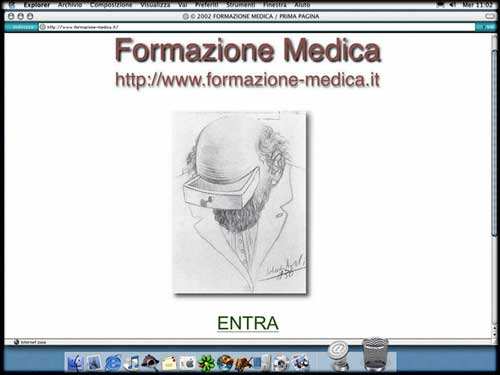 The course we realized, in the experimental stage of CME Project of Italian Ministry of Health, it's a prototype of a psychiatric course for General Medicine Physicians. We must specify that, technologically, all the system is included in a database that run all the structure: student's identification by a password, tracking control of every student in the pages and in the units, check of getting through the tests, that is necessary to receive Formative Credits, that come from attending the course. But, now, let's analyze in details the units of our prototype of online course:
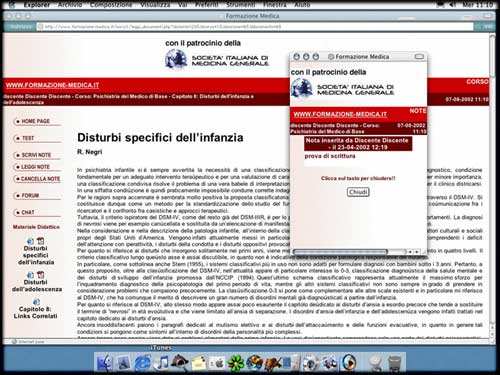
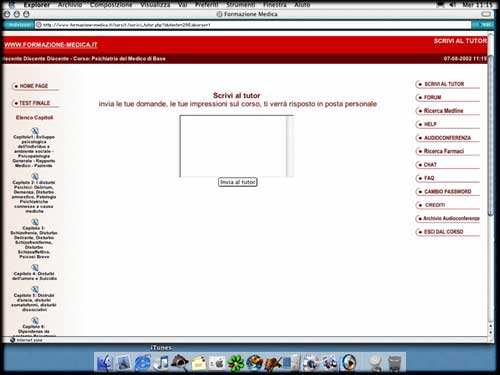 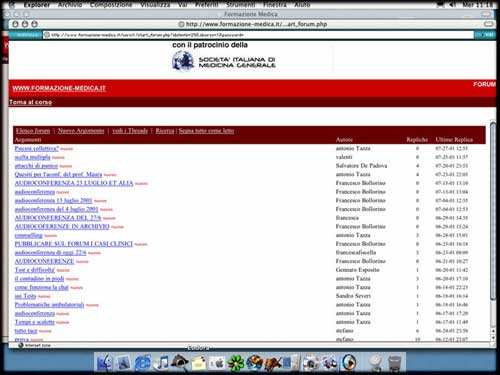 As a whole, we can say that our aim during the construction of this didactical place was to create a "place" as much like a real school where the true added value was the interaction between actors in an "ecologic" way with the creation of an "ecosystem" able to produce education and to develop eventually, constructing a real continuing education project where to return after the achieving of Formative Credits too. Drawing to the end, I'd like to underline that the project I've proposed you, technologically, is an open developing system where technology, both with regard to implementation of other functions (mainly to satisfy the didactical needs, without technological gadget, unless it improves education qualities of the system), and with regard to future integration with Mobile devices, that let us bring Continuing Education in a way in which educational place becomes a consulting and support instrument for working decisions. I'll end stressing two meaningful critical states, that can't be pass over in silence:
I think that online CME is a great occasion to exploit not only nationally, but internationally too, where distance education projects could be usefully activated, letting a low cost updating even in economically disadvantaged Hearth's Areas. Digital Divide exists, but, sometimes, technology could join and help very much. In Psychiatry, at least, I think that big organizations as WPA will have to and will able to play a central role with regard to propose advanced solutions and education of exemplary quality. |
![]()

![]()






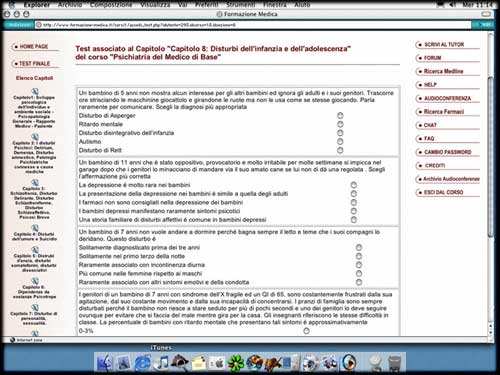 A last consideration about this first part: in the case we're analyzing, we've realized the transposition of an entire volume from the written page, to web in HTML and PDF format, but it's not always in this way. May be, the basic unit could be made up of other formats that better fit to construct the online didactical project. A problem, that we must never neglect, is "reception" band width: we've imagined a situation where the course could be used by a common dial-up 56K line and I think that we must never underestimate this bottleneck when we project online courses: real world isn't made only for high speed dedicated lines, that allow very sophisticated creations, but, often, hard usable by final common user.
A last consideration about this first part: in the case we're analyzing, we've realized the transposition of an entire volume from the written page, to web in HTML and PDF format, but it's not always in this way. May be, the basic unit could be made up of other formats that better fit to construct the online didactical project. A problem, that we must never neglect, is "reception" band width: we've imagined a situation where the course could be used by a common dial-up 56K line and I think that we must never underestimate this bottleneck when we project online courses: real world isn't made only for high speed dedicated lines, that allow very sophisticated creations, but, often, hard usable by final common user.  According to our experience, these interactive events were the most appreciated ones by students who can listen to the file, if not present at the appointed time, taking it from the Library-Archive that the system creates automatically at the end of every Conference. We could, of course, realize VIDEO CONFERENCES, but we didn't, because we thought they weren't essential and not very well receivable for the user. It's important to stress that used technology let lecturer realize his speech directly by his own PC with the only restriction to have at least an ISDN connection to the course Server.
According to our experience, these interactive events were the most appreciated ones by students who can listen to the file, if not present at the appointed time, taking it from the Library-Archive that the system creates automatically at the end of every Conference. We could, of course, realize VIDEO CONFERENCES, but we didn't, because we thought they weren't essential and not very well receivable for the user. It's important to stress that used technology let lecturer realize his speech directly by his own PC with the only restriction to have at least an ISDN connection to the course Server.